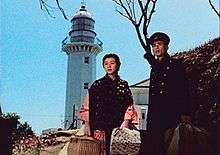Times of Joy and Sorrow
Times of Joy and Sorrow (USA title) or The Lighthouse (UK title) [Yorokobi mo kanashimi mo ikutoshitsuki (喜びも悲しみも幾歳月)] is a 1957 color Japanese film directed by Keisuke Kinoshita, who shot on location at 11 different lighthouses throughout Japan, including opening scenes at Kannonzaki, the site of the country's first lighthouse.[2]
| Times of Joy and Sorrow | |
|---|---|
 | |
| Japanese | 喜びも悲しみも幾歳月 |
| Directed by | Keisuke Kinoshita |
| Produced by | Shochiku |
| Written by | Keisuke Kinoshita |
| Music by | Chuji Kinoshita |
Release date |
|
Running time | 162 minutes |
| Country | Japan |
| Language | Japanese |
Plot
In 1932, a young lighthouse keeper returns from his father's funeral with a new bride, who quickly learns the importance of the marital bond to members of her husband's profession, which is often characterized by the hardships of physical isolation and sudden reassignment. Over the next 25 years they transfer to ten different lighthouses throughout Japan, raising two children and befriending multiple colleagues and their families. They endure wartime attacks on the strategically relevant lighthouses as well as a tragedy involving one of their children, ultimately celebrating the other's marriage and settling together into middle age.
Cast
- Hideko Takamine as Kiyoko Arisawa
- Keiji Sada as Shiro Arisawa
- Takahiro Tamura as Mr. Nozu
- Katsuo Nakamura as Kotaro
- Yōko Katsuragi as Fuji Tatsuko
- Kōji Mitsui as Mr. Kanemaki
- Kuniko Igawa as Itoko Suzuki
- Shizue Natsukawa as Mrs. Natori
- Masako Arisawa as Yukino
- Hiroko Itō as Masako
- Noboru Nakaya as Shingo Natori
- Takeshi Sakamoto as Postmaster
- Ryūji Kita as Natori
- Mutsuko Sakura as Mrs. Kanemaki
Legacy
The highly-popular film[3] has been remade three times for Japanese television,[4] and in 1986 Kinoshita himself reworked it as Big Joys, Small Sorrows, the Western version of its actual title (新・喜びも悲しみも幾歳月), which translates roughly as New Times of Joy and Sorrow.[5]
Its rousing, eponymous theme song was a major hit for Akira Wakayama and became a cultural touchstone of 1950s Japan.[6]
In 1993 a statue depicting the movie's two stars in an iconic pose from publicity materials[7] was erected at Hajikizaki Lighthouse on Sato Island, one of the filming sites, as a tribute to lighthouse staff nationwide.[8]
Availability
Although the film has not been released on disc or for streaming in the United States, Kinoshita's remake Big Joys, Small Sorrows was among the inaugural films available in Spring 2019 for streaming on The Criterion Channel.[9]
References
- http://www.jmdb.ne.jp/1957/cg003860.htm accessed January 28, 2009
- "Visit to the Kannonzaki lighthouse and coast". Education in Japan Community Blog. Education in Japan Community. Retrieved September 5, 2019.
- "Japanese Movies All Time Best 200 (Kinejun Readers)". MUBI. mubi.com. Retrieved March 17, 2019.
- "Keisuke Kinoshita Theater". Showa 1940’s TV Drama (in Japanese). Syowa40sTVDrama.com. Retrieved September 5, 2019.
- "Kinoshita's "Big Joys, Small Sorrows" (1986)". Reflections on Japanese Culture Blog. Wordpress.com. Retrieved September 5, 2019.
- "Akira Wakayama, Yorokobi mo Kanashimi mo Ikutoshitsuki". Kayo Kyoku Plus. Blogspot.com. Retrieved September 5, 2019.
- "Hajikizaki Lighthouse". Japanese Wikipedia (in Japanese). Wikipedia Foundation. Retrieved September 6, 2019.
- "Hajikizaki Lighthouse". True Sado. Sado Tourism Association. Retrieved September 6, 2019.
- "Big Joys, Small Sorrows". The Criterion Channel. The Criterion Channel. Retrieved September 5, 2019.